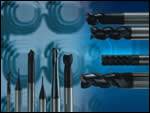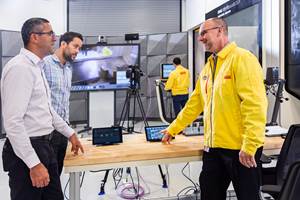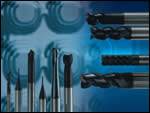Part Three of a Three-Part Series Five Steps for Improving Your Shop’s Maximum Productivity
An explanation of the differences between high-speed machining and conventional machining; and, general thoughts on when to high speed machine and heat treat versus hard milling.
Share
Read Next
Part 3 of this three-part article series will examine the final two of the five principles for improving your shop’s maximum productivity: (1) understanding and knowing the differences between high-speed machining and conventional machining and (2) when to high speed machine before hard milling.
Over the years, many different types of technology have entered the marketplace and have effectively changed and or replaced industries. These fields have ranged from agriculture, with the introduction of different types of automated machinery, to manufacturing, with advancement in cutting materials, CNC controls and linear drives.
High-speed machining (HSM) is another technology that is changing manufacturing. It is not a new technology as the principles and practice have been around for many years; however, it is often misunderstood, and/or applied incorrectly or inefficiently. In theory, the basis behind HSM—sometimes referred to as high productive machining (HPM)—is to machine at speeds and feeds beyond the workpiece melting point. In this manner, you are deflecting all of the heat into the chips and eliminating stresses in the workpiece.
While there are many different opinions and definitions of HSM, the common thread of all definitions is removing material as fast as possible while maintaining good tool life and improving the accuracy of components machined.
HSM or HPM and Conventional Machining Differences
There are many different variables to evaluate when looking to switch from conventional machining to either HSM or HPM. First and foremost is the machine itself.
Generally, a machine for high-speed machining is thought to have spindle ranges from 20,000 to 60,000 rpm. These machines will have very high table feedrates and be able to ramp up to speed very quickly. In order to achieve these rates, the machine may sacrifice some rigidity. This is only the start of HSM and could be more narrowly defined as high spindle speed machining (HSSM).
High spindle speed machining is the process of taking very small depths-of-cut both axially (ap) and radially (ae), usually around .008" maximum, and often will be used on parts that are relatively small in size, such as a cell phone mold.
Another aspect of high-speed machining, which is also referred to as high productive machining, is using a very rigid machine with a maximum of 25,000 rpm. The ma-chines will have fast table rates, but usually not necessarily as fast as a high spindle speed machine. HPM is usually characterized by large depths-of-cut axially (ap) up to 2x diameter of the cutting tool and relatively small depths-of-cut radially (ae).
Using HSSM or HPM is constantly a better choice than conventional machining. You will easily be able achieve production rates of five to 10 times faster with these principles.
As an example, a traditional milling cutter at conventional speeds and feeds will run at 100 to 200 sfm and chip loads of .003" to .005" per tooth, while when using HSSM or HPM you will run at 600 sfm and chip loads of .010" to .020" per tooth.
Keep in mind, with these advanced feeds and speeds you will need to have the correct toolholders, software and cutting tools as discussed in Part II of this article in the November issue.
The component size and the material machined will determine which machine is right for your operations. In most occasions, a combination of both methods is required for optimal efficiency (see Chart 1).
How to Apply This to Your Shop
To apply this to your shop, the first item to examine is the material you are machining, the hardness of this material, and the size and complexity of the workpiece.
Material
In very general terms if you are cutting aluminum, synthetics or graphite, you can look to HSSM as a very effective method to machine your workpieces. Most of your mold and die end mill manufacturers will recommend up to 1800 sfm for graphite and up to 2000 sfm for aluminum and synthetics. However, if your components are larger and do not require the use of end mills of the smaller range (.400" diameter and under), you will never reach the rpms of HSSM and therefore HPM may be more efficient.
On the other hand, if you are cutting mold and die steels from P20 to A2, you will probably be most effective using HPM, unless you are finishing smaller diameters such as a cell phone mold with .040" or smaller tools. At this diameter 600 sfm will give you an rpm of 57,000. Most of your aerospace materials will run in the same general parameter as the mold and die steels.
Hardness
Normally it is recommended that you use HPM on all of your tool and die steels—depending on the complexity of the workpiece and the cutting tool diameters required. Usually one works with surface speeds in the range of 300 to 600 sfm; 50 + Rc tool steels would run 300 to 400 sfm; and, your softer steels would run from 400 to 600 sfm.
Complexity of the Workpiece
This is usually the largest determinant if HSSM or HPM would be required. Your smaller workpieces will usually require radii in the corners as small as .003". Some shops require tool diameters of .003". Whenever you are this small, HSSM will be the method of choice.
When to High Speed Machine and Heat Treat Versus Hard Milling
Now for the last part of the equation, when do you rough via HSSM or HPM, and then heat-treat or machine the part in the hardened state by hard milling processes.
A general rule of thumb—which is not cut and dry—would be determined by the size of the component. If your component were the size of a cell phone, then it usually would be better to machine this completely by hard milling. In addition, if your finish workpiece material is in the 45 to 50 Rc range, you will probably save time and money by hard milling rather than machining it soft, heat treating and machining it a second time.
All of the important features mentioned in this article and its previous installments are critical if you are going to machine components by hard milling. You should have the proper toolholders; .0001" or less of run out; rigid machine setup; machine tool controllers that can read well in advance of the current line; cutting tools with the proper geometry and coatings; as well as CAM software to eliminate contact surface of the cutting tool.
Summary
Over the last three issues, we have briefly discussed five quick and simple recommendations for improving your productivity in the die/mold industry. If you have taken one thing from this series, it should be that advancements in technology are available in the industry. Research the advancements and ask the right questions of how the advancement can help your productivity, and most importantly, implement the advancements that can benefit your company.
Related Content
How to Overcome Cutting Tool Vibration
Advanced indexable milling cutting tool design provides secure, predictable machining, increased metal removal rates, reduced cycle times and fast changeovers.
Read MoreHow to Use Continuing Education to Remain Competitive in Moldmaking
Continued training helps moldmakers make tooling decisions and properly use the latest cutting tool to efficiently machine high-quality molds.
Read MoreTreatment and Disposal of Used Metalworking Fluids
With greater emphasis on fluid longevity and fluid recycling, it is important to remember that water-based metalworking fluids are “consumable” and have a finite life.
Read More3D Printing Enables Better Coolant Delivery in Milling Operations
Just like 3D printing enabled conformal cooling channels in molds, additive manufacturing is now being used to optimize coolant delivery in cutting tools.
Read MoreRead Next
Part One of a Three-Part Series Five Steps for Improving Your Shop’s Maximum Productivity
Learn how to evaluate your shop’s productivity and begin increasing it by considering the variables of implementing hard milling and high-speed machining.
Read MorePart Two of a Three-Part Series Five Steps for Improving Your Shop’s Maximum Productivity Part 2
The reasons and justification behind moving your component finishing operation from EDM sinking to hard milling with the right machine, software, cutters, toolholders and training; and how you can add machine time to your shop through lights out machining.
Read MoreHow to Use Strategic Planning Tools, Data to Manage the Human Side of Business
Q&A with Marion Wells, MMT EAB member and founder of Human Asset Management.
Read More.png;maxWidth=970;quality=90)










.png;maxWidth=300;quality=90)










